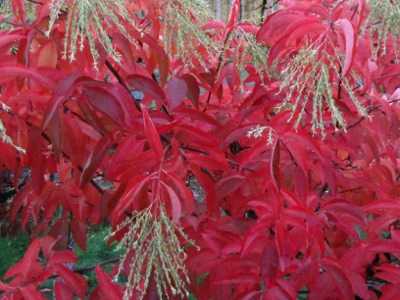Sourwood Tree
Category: Deciduous Trees

Facts about Sourwood Tree, Facts about Sourwood Tree is Oxydendrum arboreum". Sourwood is the only tree variety existing in the Oxydendrum tree genus. This big shrub or small tree belongs to the Ericaceae family that hails from the eastern part of North America. The Sourwood Tree is often seen as a part of oak-heath forests. This ornamental and shade tree has a medium growth rate and grows well in full sun. The Sourwood Tree grows well in a variety of soils, such as alkaline, acidic, sandy, loamy, well drained, clay and extensive range soils. The Sourwood Tree attains an oval, pyramidal shape with its widespread branches when fully grown. The Sourwood Tree has few disease or pest problems and it can be treated effortlessly for the ones it does come across.
Features of Sourwood Tree
A well developed Sourwood tree is capable of attaining a height, ranging from 25 feet to 30 feet (7.6 to 9.1 cm), with widespread branches that have a maximum spread of 20 feet (6 cm). The bark of the Sourwood Tree is profoundly furrowed and scaly, and its color is gray with a reddish hint. Initially, the branch-lets of the Sourwood Tree appear with light yellowish green color, but afterward, they will change to reddish brown. The wood of the Sourwood Tree is reddish brown in color, with paler sapwood, which is hard, heavy, and close-grained, and will acquire a high shine.
The leaves of the Sourwood tree are deciduous and they are arranged spirally. These leaves are simple, alternate, oblong, or elliptic and their length ranges from 3 inches to 8 inches (7.62 to 20.3 cm), and the breadth varies between 2 1/2 inches and 3 1/2 inches (6.4 to 1.3 cm), with a thinly serrated border. These leaves attain dark green color during the summer season, but they will turn to bright red color during the fall.
The Sourwood tree produces flowers from June to early July, and they are white in color. When these flowers are completely bloomed, they attain the shape of a bell and offer a pleasant aroma. The length of these flowers ranges from 1/4 inches to 11/32 inches (.63 to .89 cm), produced on panicles whose length ranges from 6 inches to 10 inches (15.2 to 25.4 cm).
The Sourwood tree offers fruit with a diameter of 1/2 inches (1.27 cm), and they are oval-shaped when fully grown.
A Full grown Sourwood Tree can absorb as much as 48 pounds (21.77 kg) of carbon dioxide a year. The same tree could also produce enough oxygen in a day for two people. In a single day, a large Sourwood Tree can drink up to 100 gallons (378.5 liter) of water from the ground and discharge it into the air.
You can tell a Sourwood Trees age by the number of growth rings. Growth rings size shows what kind of conditions accrued that year, the temperature and if it was a dry or wet year.
Bark of the Sourwood Tree protects it from the elements and is made up of dead cells.
Sourwood Tree roots usually grow two to three times the width of the tree branches. The ideal time to fertilize your Sourwood Tree is in late fall or early spring. If you want to transplant a tree do it in fall, this is ideal for most trees.
Uses of Sourwood Tree
The leaves of the Sourwood tree are used to prepare tea due to their acrid taste. The tea brewed from these leaves is extensively used by mountain climbers to reduce their thirst. The tea is also used to treat indigestion, diarrhea and dysentery. Pioneers employ sap as an ingredient in a drink, employed for treating fevers. The bark of the Sourwood Tree can be chewed to alleviate mouth pains. The Sourwood Tree is famous for nectar and honey. The Juice prepared from its blooms is used to prepare sourwood jelly. The shoots of the tree are used to construct arrow shafts.
The average lifespan of the Sourwood tree is about 80 years.
Sourwood Tree leaves are made up of many colored pigments, green chlorophyll hides the colors during the growing season of spring and summer. As days get Shorter and cooler temperatures come in the fall, it cause the chlorophyll to break down and than the other color pigments can be seen.
Sourwood Tree growth is referred to as Meristem (The undifferentiated embryonic plant tissue from which new cells are created, as that at the tip of a root or stem). This tissue can be found at the tips of shoots and leaves. Inside the stem growth in thickness occurs at the vascular cambium.
Sourwood Trees make their own food from sunlight, carbon dioxide, water, and nutrients from the soil.

 Back To Category Deciduous Trees
Back To Category Deciduous Trees